Lu Zeera, Circassian Lady Magician and Fire-Queen

One of the iconic tales of Australian goldfields history is that of the pseudo-Spanish dancer, Lola Montez (or Montes) who, on February 20, 1856, attacked the editor of the Ballarat Times, Henry Seekamp, with a whip after his paper condemned her notorious behaviour. (1)
Twenty years later, Lu Zeera, Circassian Lady Magicienne and Fire Queen, took a leaf out of Montez’s book and went after some of her audience members with a horsewhip. That story later.
Lola Montez Spider Dance
Arrival in Australasia – the Exhibition of Living Wonders
In early April, 1875, the ship ‘Hero’ arrived at Sydney from Auckland, New Zealand. On board were Miss Matilda Sanville, Mr. C. H. and Frank Hoberg, and Mr. Moulton. It is unclear when the Hobergs had become managers, or which of the two might have been in charge, but in Australia they travelled under the title “Hoberg’s American Exhibition (sometimes ‘museum’) of Living Wonders.”
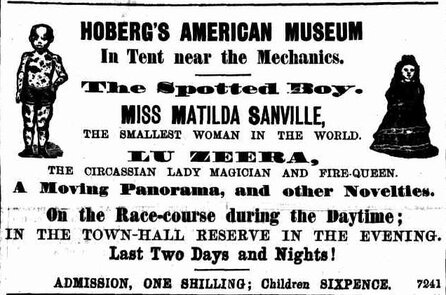
September 29, 1875
The ‘performers’ had been appearing in New Zealand as early as March 1875 in Auckland, though no mention was made of the Hobergs at that time. “Performer” is a loose term, as these were players in the curious phenomenon of “Living Wonders”, a close relation to the old Freak Show, but made almost socially acceptable by the likes of Phineas Taylor Barnum and his ‘American Museum’. Unusual people with physical differences or strange abilities exhibited themselves for the curiosity of the local populace and, under Barnum’s style of showmanship, they would often adopt exaggerated and exotic back-stories to enhance their attraction. Effectively these were travelling showpeople, appearing under canvas.
Matilda Sanville, sometimes promoted as the ‘Fairy Queen’ was said to be 19 years old and just 31 inches in height. Her appearances consisted of making polite conversation and singing; and on occasion the public were permitted to kiss her hand. (2)
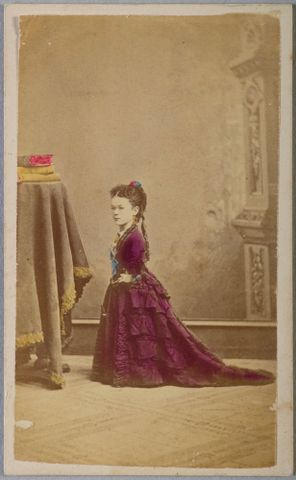
A young lad, about 13, promoted as “The Leopard Boy” or the “Spotted Boy from the wilds of Africa” and occasionally “Imprimis”, was in reality an African or Afro-American whose skin had varied patches of light and dark pigmentation, and hair both black and white. He would dance when requested, and made a good business selling photographs of himself.
Mr C. E. Moulton was a Lightning Calculator, solving mathematical problems at great speed. His advertising claimed that he was formerly of Barnum’s Museum, though the best-known of Barnum’s calculators was William S. Hutchings (1832-1911)
At other times, Chip the intelligent dog, and Professor Radcliffe the musician appeared, which also featured panoramic scenes from around the world.
Our magicienne, Lu Zeera, is not mentioned in New Zealand, and if she came to Sydney with the others, she was clearly travelling under another name. The rapid and fluid formation and disbanding of various performing “troupes” makes it difficult to track their fortunes.
In any case, Hoberg’s American Exhibition moved around at a rapid pace, being seen in Newcastle in early May, then over to Adelaide (South Australia) in July, Bendigo (Victoria) in November, and then returning to New Zealand by December (Invercargill), remaining there until late February. In late March they were in Brisbane (Queensland), Toowoomba on April 5, and the troupe was last noted in Sydney (New South Wales) on April 24. Lu Zeera, however, seems to have severed her relationship with Hoberg’s very soon after arriving in Australia, and we can now direct our attention to her activities.
The Phenomenon of the Circassian Beauty
Lu Zeera was promoted as “The Circassian Lady Magician and Fire-Queen”. Unpacking this title takes us into more of the strange world of P.T. Barnum.
The Circassians were a group indigenous to the Caucasus, with a sad history of genocide as Russia fought to access the Black Sea (Caucasian War 1817-1864). Reputedly the Circassians were the fair-skinned exemplar of human beauty .
Seeing an opportunity to capitalise on dramatic and exotic stories of beautiful women escaping from a life of white slavery, P.T. Barnum in 1864 effectively invented (3) a genre of museum exhibition performer, the ‘Circassian Beauty’. Supported by a phony narrative of her life, the Beauty was notable for having a huge mass of frizzy hair, and typically a name beginning with a “Z”. By the 1880s the Circassian Beauty was a fixture in most ‘freak show’ or ‘exhibitions’, often using Afro-American or Fijian women, or just women who frizzed their hair up with the use of beer or other products.
It is notable that one of Barnum’s own featured Circassians was “Zobeida Luti”, promoted as the only lady magician in the world, and while it may be tempting to associate Lu Zeera with this performer, no evidence currently supports it. Until late in 1876 Lu Zeera’s heritage, and whether she even followed the Barnum-esque concept of Circassianism, remains unknown.
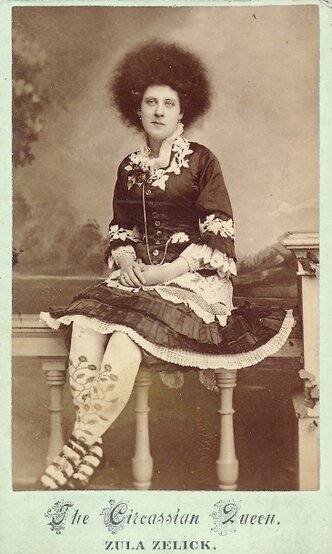
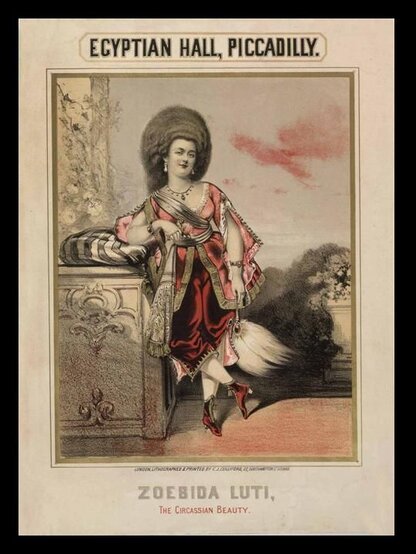
Lu Zeera, Lady Magician
Whether or not Lu Zeera had come from New Zealand with the Hoberg exhibition, by September 25, 1875, she was featuring with them in Goulburn, NSW, in a tent near the Mechanics’ Institution. Hoberg’s Museum and Zeera moved to Wollongong in early October, but by November 6 the split was made, and Zeera was announced to perform at Clontarf (Sydney) on the Prince of Wales’ birthday Gala, “Drinking boiling lead, fire eating &c. Luzeer [sic] will perform the latest Asiatic illusion of Legerdemain.” Her talents also included eating needles.
She quickly moved to Hobart, Tasmania, appearing from December 20 at the Theatre Royal with the “U.S. Magnet Troup”, another group who are seen only briefly around that time, and only within Tasmania. Mr J. H. Power, a well-known Irish Comedian and vocalist, appears to have been the manager.
Notably, Lu Zeera was now accompanied by Lena Leoni, the ‘entranced child’ in what can be assumed to be a version of Robert-Houdin’s ethereal suspension trick. Leoni had a mixed career as a “Parisian” magician, and as a co-performer to Professor Hennicke . She also seems to have performed as an act separate to Zeera, “The denizen of the air, in her Illusory, Mimetic, Chatty, Mysterious and Peculiar Illusions, introducing her famous Egyptian Mystery and Indian Marvels.” (none of which tells us much about her act!)
Alas, Lu Zeera and the Troupe came in for heavy criticism in the Tasmanian Tribune of December 21:-
“Then followed the performance of one who was styled in the advertisements as “Lu Zeera, the Circassian, and Lady Magician and Fire Queen.” Her magic, such as it was, was very clumsily and ungracefully performed, and it was with relief expressed in hooting that the audience witnessed her departure from the stage… a young girl, bearing the euphonious title of “Lena Leoni, the denizen of the air” [entered]. With the magical aid of “Lu Zeera” she went through a bad imitation of a portion of Dr. Silvester’s (4) well-known entertainments. On a platform at the back of the stage, which was darkened, this girl was made to appear suspended in mid-air with no other support than that of an upright rod place under the elbow…. Then followed a long interval of waiting filled up by whistling, shouting, and hooting on the part of the “gods”, amid which the more respectable portion of the audience quitted the building…. the curtain fell on one of the greatest failures in the entertainment line which we have ever seen.”
Undaunted, the papers of December 22 announced another performance, following an “Enthusiastic Reception” !
By January of 1876, Zeera had formed another alliance with a group named the XLCR Variety Troupe (ie, Excelsior) still including Harry Power as the lead comedian, and towards the end of the month they were appearing in Burnie (TAS.) on what was described as a tour of the North West Coast. This troupe, fortunately, was much better received than the Magnet Troupe; they had full houses, and the Weekly Examiner described “Lulu Zeera” as being ‘dressed in Asiatic costume, astonishes the natives by her wonderful skill’. It was the troupe’s intention to visit Table Cape and work their way back to Launceston in the North East, performing at other townships along the way.
However, the Examiner reported on February 5 that Zeera had dissolved her connection with the Company and had given a farewell performance. After an appearance on February 8 at the Longford Assembly Rooms, she moved southwards, to the Huon region in March, and Spring Bay on the east coast for April 22 and 31 (‘the tricks were good and were well done, the audience testifying their approbation repeatedly’).
Zeera was advertised back in Sydney during May, with an upcoming performance for the Queen’s Birthday celebrations on Manly Beach, together with her “Entranced Girl”, Lena Leoni. By August 18 the pair were at Ziem’s Assembly Rooms in Bulli, where Leoni performed a Drawing-Room Séance. Another performance at the Temperance Hall was meagrely attended, but other performances were advertised for Dapto, Albion Park, and Kiama up to the first week of September.
At last, from a report of Lu Zeera and company in Bega School of Arts, October 19, we get a sense of what magic was in the show. (5) :-
‘She consumes fire and needles with apparent relish, manufactures a pudding in a borrowed hat, and performs a great many very clever card tricks. Some fun was caused by the flour dredge trick, and the discovery of an egg in the whiskers of a gentleman in the room. The entranced girl was placed in a horizontal position without any “visible means of support,” the illusion being quite as cleverly done as the Fakir of Oolu manages it. A negro farce of rather broad fun concluded the entertainment, which was repeated with change of programme last night. This evening will be the closing night here, and on Monday and Tuesday they appear at Candelo.’
Battling the Audience – incident with a Whip
The difficulties of dealing with unruly audiences were ever-present, and Lu Zeera had a couple of exciting battles with a member of her audience, the first being in late October during the Bega season. One Charles Challinor had created a disturbance and damaged property belong to Mr. William Burton and the performing company, for which offence he was assaulted by Mr. Burton. Challinor had Burton charged with assault; but as the complainant was the aggressor, the case was dismissed on October 24.
Lu Zeera, however, was up before the court on the same charge, and in what was said to be “her ignorance of the English Law and language”, she pleaded guilty and was fined a shilling and costs. Humorously, she was given the option of ‘imprisonent until the rising of the court’, and by sitting in the court until the finish of the trial, she cheated Challinor of his fine and costs. Even worse for Challinor, he was fined 40 shillings and costs, coming off the worst of the whole case.
The remark about Zeera’s understanding of the language is of interest; it may indicate that she was in fact of some foreign heritage, and could well have been genuinely of Circassian background.
In early November reports started to appear of a much more vigorous dispute. Because of mis-reported dates it is unclear whether this was the same battle, or a second.
The possible sequence of events is that Challinor (or Challoner) had appeared in court before Messrs. Lane, Peden and Jauncey on October 24 and, unhappy with the outcome, had attended another performance during the following week, probably the 28th. This time he was accompanied by Francis Tully, and the press described them as “Larrikins” which, unlike today’s mild definition, originally meant a gang member.
The news article which originated in the Bega Gazette of [October 29 - see note (6)] reported:-
“A case heard by his Worship, Mr. John Davis, on Saturday morning excited some interest. On the previous evening the troup of “Lu Zeera,” the Circassian Lady Magicienne and Fire Queen,” performed in the School of Arts. Some juveniles in the audience did not approve of the entertainment, and, at the close, signified their disapprobation by a fusillade of rotten eggs. One of the eggists came under the eye of “the lady” and the performance over, she went home, vowing vengeance dire and deep.
Accordingly, next morning, armed with a muscular-looking cart whip, Lu Zeera marched to search for the offender, upon whom, when found on the back premises of the Commercial, she poured, by aid of the whip, the pent-up vials of her just wrath. Her attack was seconded by a masculine member of the troupe; but before the passage of arms could be decided, Constable Cochrane stayed proceedings, and marched the belligerents each into a cool cell. Soon after eleven, the pair, Charles Challoner and Francis Tully, stood in the deck, and his worship, having heard the evidence of the apprehending constable, bound the parties in their own recognisance of £10 each to keep the peace for six months.”
A few weeks later, at Cooma, Zeera had an audience ‘a trifle uproarious, not too choice in their language – that is, many of the young men – but on the whole, they were not at all as naughty as the boys of Bega.’ (7)
In tribute, no doubt, to the redoubtable Magicienne’s use of the whip, a horse racing in the Bega Trial Stakes was named “Lu Zeera”!
By January 1877, Lu Zeera was back in Sydney, performing in the ‘Sons of Temperance’ Grand demonstration at the Exhibition Building (Prince Alfred Park, near today’s Central Station) (8)
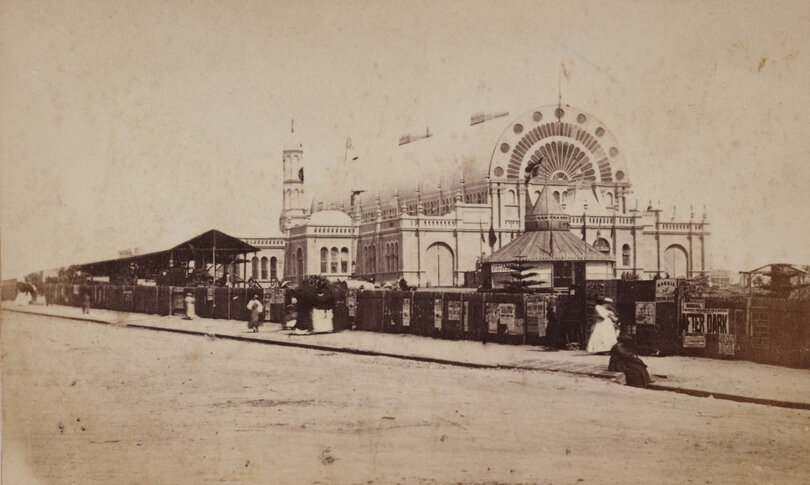
Exhibition Building
It seems reasonable to expect that she continued to be a regular performer, but during the following year her notices start to fade away. She appeared on the racecourse of the Illawarra Turf Day in October, then at the Maitland Annual Show in mid-August of 1878, in a tent, but no more is heard from the Circassian Lady Magician.
One of her final acts of defiance was to write to the Evening News (Sydney) objecting to an article they had printed (9), titled “Paddy’s Market on Saturday Night”, which referred to a lady fire-eater in humorously unkind words. This, said Lu Zeera, was not her – to which the newspaper replied that it was hardly necessary to say that she was not the person referred to. As the “Paddy’s” story is of interest for its amusing insights into contemporary social life, we have reproduced it, below.
REFERENCES:
(1) Lola Montez, otherwise Eliza Rosanna Gilbert, claimed Spanish ancestry but was born in Ireland around 1818-21. Her notoriety as a courtesan began early with numerous marriages, affairs including trists with Franz Liszt and the Bavarian King Ludwig 1, and an earlier scandal in 1844 in which she whipped a military officer across the face. Her Australian journey began in 1855 when she performed in Sydney and Melbourne; having taken dance instruction, her infamous “Spider Dance” was said to have involved a frenzied search up her legs for a spider, during which her dress was lifted so high that audiences could clearly see she wore no undergarments.
During her appearances on goldfields of Ballarat in 1856, The Ballarat Times published an anonymous letter from “Civis” in which Montez was harangued as being “simply notorious” rather than having any real ability – “one who is famed for having the form of a woman combined with the characteristics of a man, and having set at nought those laws by which the social framework of society is held together.”
Spotting the editor of the Times at the United States Hotel, Montez took a whip which she had won as a prize only a few hours earlier, and laid it around Seekamp’s head and shoulders. He retaliated in like manner, and before the two were separated they were clutching at each other’s hair, and revolvers were being drawn, presumably by onlookers.
Montez died of syphilis in 1861.
See the Bendigo Advertiser February 23, 1856 for a full article on Montez’ speech to her audiences following the incident.
and a short history of her notorious life:
(2) Matilda Sanville http://blog.tepapa.govt.nz/2015/09/28/curious-miss-matilda-sanville-the-smallest-lady-in-the-world/
(4) Alfred Silvester, the Fakir of Oolu
(5) The Bega Standard and Candelo, Merimbula, Pambula, Eden, Wolumla and General Advertiser, October 21, 1876.
(6) The original article from the Bega Gazette cannot be found online. Newspapers which attributed the story back to the Gazette, variously reported it to be from either October 25 or 29, which would affect the timeline of the dispute.
(7) Manaro Mercury, and Cooma and Bombala Advertiser, November 18, 1876.
(8) http://collection.hht.net.au/firsthhtpictures/fullRecordPicture.jsp?recnoListAttr=recnoList&recno=37810
(9) Text of “Paddy’s” sourced from Kiama Independent, August 31, 1877.
Paddy's Market on Saturday Night.
Nothing elsewhere in the city prepares us for the scene which Paddy's Market presents on Saturday night. It is altogether new. There are fresh faces, if not fresh goods. An endless medley of trades, and a system of business which enables the vendor to dispose of his goods and sell the purchaser at the same time. A perfect babel of voices, each striving to excel the other, with sounds of the drum and fife and barrel-organ intervening. A glare of light - an atmosphere of smoke enriched with the odour of burning oil. A surging diversified mass of people; all these make what is to be seen Saturday and heard at Paddy's Market on Saturday night. As early as 2 o'clock in the afternoon the square begins to look up, but it is not till 7 that the crowd assembles. The merry go-round is to set the ball rolling, the dulcet strains of the drum and fife awakening the whole neighbourhood. The band has inveterate attachment to "Yankee Doodle”; in fact there is no variation, except when in the drummer goes too often to the can, which there is no answering for him. He does not miss the drum however, nor does the fifer miss the beer - till too late.
The next business to arrive is the "hot pea" man - purely an American institution, got up for trotting matches. The business is divided, of the merry-go-round at once for here as elsewhere people to enjoy them solves, must eat. The activity and antics of this fellow are surprising; his talk is rapid and amusing, as if used to allow his dishes to glide down without observation. Others that arrive after him are mere imitators, and use much more corn and tallow. Two and three deep the boys crowd around with steadfast eyes on the man himself; their ears are back in fair delight. The ingredient that he has bottled up is the "Elixir of Iife," or something like it, for a dish without a dash is quite unacceptable. The boys joke and laugh and enjoy the thing ; five hours later they are roaring with pain. Next comes the "sausage man." with smoke issuing from his chimney and oaths from his mouth, and from whose furtive glances the canine family dart in wholesome dread. "Well, Tank, how's trade?" "Good, my boy, good," replies the pea man. "How much fat ha' you got?" Plenty for both; only you must give 'em less."'Right; who'll be the next?" The sausage man gets into position and at once opens.
The shooting gallery, the weighing and strengthtesting machine men, the vendor of sweetmeats, more sausage and hot pie and hot pea men arrive in quick succession; and what two hours before was a barren spot is now a feasting ground. The circular bycicle [sic] makes a start now that the organ grinder is a little more sober; the man at the long tent is making up and painting the board without, while the young ladies are doing the same within. The hour is arriving; it is long past o'clock, in fact it is The 6 near 7. hot pea people are secretly jubilant. Women even are patronising them, and the sausage men are all but idle. hot But the crowd swells; peas are not obtainable without delay, and the sausage men come in for a share of patronage ; all are up to their very eyes. The talk is great and funny; and many haven't time to great and funny; and many haven't time to distinguish between dishcloths and hand kerchiefs. Men, women, and children stand around in a circle with the glare of the fat-top upon them. At peace with the world they seem for the moment; their satisfied countenances speak delight. Feasting is enjoyed wherever the eye turns : it's like a religious feast, only you get more It's for your money. It’s a brilliant scene, and yet a dark one; for no man knows what he gobbles down.
But the feasting must end, and the bicycle and the "varied entertainment" divide the shilling. We prefer the entertainment. " Just a going to begin" the man at the door cries out. "Step, in ladies and gentlemen - A unique and varied entertainment, and the charge is only six pence- Miss Smith (fancy that for a rare name!) in her sleight-of-hand - The only genuine fire-eater in Sydney." The little man just entering with his wife gives a shrug of doubt at this, and all at once goes into the reflective mood, from which he is awakened by the man at the door asking in a gruff voice whether he thinks he can go in for nothing. The proud ancestral blood starts backs from Mrs. Simpkin's red face, and she secretly wishes she had Simpkins at home. We follow the Simpkin's in. The curtain is up, and the first part in the tragedy is about to be enacted. " What a brazen lump" Mrs. Simpkins ejaculates. “She's pooty, though," remarks Simpkins, stretching his neck to get a good view of Miss Arabella Smith. '" Pooty indeed," says Mrs. Simpkins ; " Where's your eyes. Why, you could see the paint through burnt glass." "Not at all ; that's nat'ral, woman, repeated Simpkins in tones of confidence, now that he was in public. Never before did Mrs. Simpkins feel so jealous. " Ridiq'lus, she replied, and looked unutterable at her better half, who was now, however her perfectly oblivious of presence, but wrapt in admiration of the stage beauty. "Miss Smith, ladies and gentleman," says the man at the foot of the stage after stopping the organ grinder; " Miss Smith will now eat fire, and swallow the blade of a sword, two of the principal acts in the conjuring; and she will then proceed to exhibit her sleight-of-hand." "Her what's that?" inquires the amorous Simpkins of his wife. "Why, ventrick wolism, of course," responds Mrs. Simpkins. Meanwhile Miss Arabella struts up and down the five foot stage, showing to advantage her make-up from the "cast-offs” of fourth robbers and third-rate equestrians. We'll not proceed to criticise [obscured text] the fire is eaten and the sword swallowed to the satisfaction of delighted Simpkins. Simple tricks in legerdemain follow, and the husband slips round to the door to learn the takings. "Six-and six; is that all'. He immediately makes a sign to his wife, and the organ grinder receives word to turn off " God save the Queen”, which he succeeds in doing after playing a bar of St.Patrick’s Day, the Marcellaise, and some other tune in his endeavour to commence at the right point. The people at once retire, and do the proprietor and his man to the nearest public house. The entertainment is repeated. As crowds come out, others are taken in, and so the affair proceeds throughout the evening.